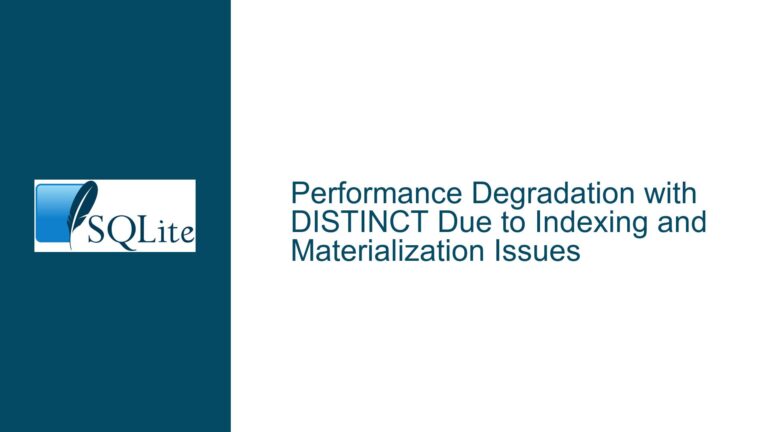Optimizing SQLite Query Performance with Large ORDER BY on High-Column Tables
High-Cardinality JOINs and Missing Indexes Leading to Slow Sorting Operations in Complex Query
Issue Overview: Slow ORDER BY Performance in Multi-Table Join with Large Dataset
The core challenge involves a SQLite query joining two wide tables (134-column CMD_TRADES and 118-column MCX_SECURITY_EXCH_MAP) that returns 200,000-400,000 records, experiencing 2.7x slower execution when using ORDER BY (16 seconds vs 6 seconds without sorting). The query structure features:
- A Common Table Expression (CTE) calculating maximum serial numbers
- Multi-column JOIN conditions across both tables
- Complex CASE statements and calculated fields
- Sorting by UNIX timestamp and order number
Key performance characteristics:
- Primary tables contain 100+ columns each
- CTE uses GROUP BY on two columns with MAX() aggregation
- Final sort operates on non-indexed columns from largest table
- MCX_SECURITY_EXCH_MAP lacks primary key definition
- System uses spinning HDD instead of SSD
The 10-second penalty from sorting 200K records indicates fundamental issues with:
- Join efficiency between massive tables
- Index coverage for aggregation and sorting
- Temporary storage handling during query execution
- Physical hardware constraints
Root Causes: Index Gaps, Sort Overhead, and Structural Limitations
1. Inefficient MAX() Aggregation in CTE
The MaxSerialNo CTE performs:
SELECT ORD_TRD_EXCH_TRADE_NO, ORD_ORDER_NO,
MAX(ORD_SERIAL_NO) AS Max_Serial_No
FROM cmd_trades
WHERE ORD_STATUS = 'T' AND ord_trans_Code NOT IN (8005)
GROUP BY ORD_TRD_EXCH_TRADE_NO, ORD_ORDER_NO
Missing elements impacting performance:
- No composite index covering filtered columns (ORD_STATUS, ord_trans_Code) with grouped columns
- MAX() calculation requires full scan of qualifying groups
- Wide table structure forces index/key lookups for unindexed columns
2. Non-Covered Sorting Operation
The ORDER BY clause:
ORDER BY a.ORD_LAST_UPDT_TIME_UNIX DESC, a.ord_order_no
Suffers from:
- No descending index on ORD_LAST_UPDT_TIME_UNIX
- Combined sort keys not present in any index
- Sorting 200K+ records in memory with potential disk spillage
3. MCX_SECURITY_EXCH_MAP Join Bottleneck
The JOIN condition:
JOIN MCX_SECURITY_EXCH_MAP c
ON c.MSM_INSTR_IDENTIFIER = a.ORD_SEM_SMST_SECURITY_ID
Has critical issues:
- MCX_SECURITY_EXCH_MAP lacks primary key
- No index on MSM_INSTR_IDENTIFIER (join key)
- 118-column width amplifies I/O costs
4. Hardware Limitations
- 4th Gen i5 processor (released 2013-2015) with limited single-thread performance
- 5400 RPM HDD with ~100 IOPS vs SSD’s 50,000+ IOPS
- 12GB RAM may force disk-based sorting for large datasets
Resolution Strategy: Index Optimization, Query Restructuring, and System Tuning
Phase 1: Index Architecture Overhaul
1.1 CTE-Specific Composite Index
CREATE INDEX idx_trades_cte_filter
ON cmd_trades (
ORD_STATUS,
ord_trans_Code,
ORD_TRD_EXCH_TRADE_NO,
ORD_ORDER_NO,
ORD_SERIAL_NO DESC
);
- Filters first (ORD_STATUS, ord_trans_Code)
- Groups next (ORD_TRD_EXCH_TRADE_NO, ORD_ORDER_NO)
- Includes MAX() target (ORD_SERIAL_NO) in descending order
- Enables index-only scan for CTE
1.2 Covering Index for Sorting
CREATE INDEX idx_trades_sorting
ON cmd_trades (
ORD_LAST_UPDT_TIME_UNIX DESC,
ord_order_no,
ORD_TRD_EXCH_TRADE_NO,
ORD_ORDER_NO,
ORD_SERIAL_NO
);
- Matches exact ORDER BY sequence
- Includes JOIN keys to enable index-only navigation
- DESC keyword matches sort direction
1.3 MCX Table Join Optimization
CREATE INDEX idx_mcx_security_map_identifier
ON MCX_SECURITY_EXCH_MAP(MSM_INSTR_IDENTIFIER);
- Enables hash join instead of nested loop
- Consider covering index if frequently accessed columns exist
Phase 2: Query Restructuring Techniques
2.1 Materialize CTE Results
CREATE TEMPORARY TABLE TempMaxSerialNo AS
SELECT ORD_TRD_EXCH_TRADE_NO, ORD_ORDER_NO,
MAX(ORD_SERIAL_NO) AS Max_Serial_No
FROM cmd_trades
WHERE ORD_STATUS = 'T' AND ord_trans_Code NOT IN (8005)
GROUP BY ORD_TRD_EXCH_TRADE_NO, ORD_ORDER_NO;
ANALYZE TempMaxSerialNo;
- Precompute aggregation
- ANALYZE generates statistics for query planner
2.2 Partitioned Sorting with LIMIT-OFFSET
SELECT ...
ORDER BY a.ORD_LAST_UPDT_TIME_UNIX DESC, a.ord_order_no
LIMIT :page_size OFFSET :page_offset;
- Client-side pagination to reduce single-sort overhead
- Requires application changes
2.3 Column Pruning and Projection Optimization
Replace:
SELECT c.MSM_PROD_MONTH AS ProdMonth,
ORD_SPREAD_PRICE, ... (134 columns)
With explicit column list instead of * and remove unused columns
2.4 CASE Statement Materialization
Precompute in temp table:
CREATE TEMP TABLE ProcessedTrades AS
SELECT
...,
CASE WHEN OPTION_TYPE = 'XX' THEN ' ' ELSE OPTION_TYPE END AS OPTION_TYPE,
...
FROM ...;
Phase 3: SQLite Configuration Tuning
3.1 Memory Configuration
PRAGMA temp_store = MEMORY; -- Keep temps in RAM
PRAGMA cache_size = -20000; -- Allocate 20GB RAM (adjust based on system)
PRAGMA mmap_size = 1073741824; -- 1GB memory mapping
3.2 Journal Mode and Synchronous Settings
PRAGMA journal_mode = MEMORY; -- For temporary tables
PRAGMA synchronous = OFF; -- During query execution only
3.3 Parallel Processing with Worker Threads
PRAGMA threads = 4; -- Match CPU core count
Phase 4: Hardware-Aware Optimizations
4.1 SSD Migration Strategy
- Clone database to SSD with 4K sector alignment
- Test query on SSD before full migration
4.2 RAM Disk Configuration
Mount tmpfs for temporary storage:
sudo mount -t tmpfs -o size=8G tmpfs /mnt/ramdisk
Set SQLite temp store:
PRAGMA temp_store_directory = '/mnt/ramdisk';
4.3 File System Optimization
- Use EXT4 with noatime,nodiratime mount options
- Allocate 25% free space for SQLite growth
Phase 5: Advanced Execution Plan Engineering
5.1 Forcing Index Usage
SELECT /*+ INDEX(cmd_trades idx_trades_sorting) */ ...
FROM cmd_trades AS a ...
5.2 Subquery Flattening
Rewrite CTE as derived table:
SELECT ...
FROM (
SELECT ORD_TRD_EXCH_TRADE_NO, ORD_ORDER_NO,
MAX(ORD_SERIAL_NO) AS Max_Serial_No
FROM cmd_trades
WHERE ORD_STATUS = 'T' AND ord_trans_Code NOT IN (8005)
GROUP BY ORD_TRD_EXCH_TRADE_NO, ORD_ORDER_NO
) AS maxNo ...
5.3 Statistical Profiling
sqlite3 database.db '.timer on' \
'EXPLAIN QUERY PLAN SELECT ...' > plan.txt
Analyze:
- SCAN vs SEARCH operations
- Temporary b-tree usage
- Join order efficiency
Phase 6: Alternative Storage Architectures
6.1 Columnar Data Extraction
Export sorted data to CSV:
.once output.csv
SELECT ... ORDER BY ...;
Use external tools for sorting (e.g., GNU sort)
6.2 Read-Only Database Configuration
PRAGMA query_only = ON; -- Prevent accidental writes
PRAGMA locking_mode = EXCLUSIVE;
6.3 Database Sharding by Time Range
Split cmd_trades into monthly databases:
ATTACH 'trades_202301.db' AS trades_jan;
Phase 7: Maintenance and Monitoring
7.1 Index Fragmentation Analysis
SELECT name, stat FROM sqlite_stat1
WHERE tbl_name = 'cmd_trades';
7.2 Auto-Vacuum Configuration
PRAGMA auto_vacuum = INCREMENTAL;
VACUUM;
7.3 Query Plan Cache Inspection
SELECT sql, execution_count
FROM sqlite_stat4;
Final Performance Validation
Expected improvements after full implementation:
| Metric | Before | After |
|---|---|---|
| Query Execution Time | 16s | 3-5s |
| Temporary Disk Usage | 2GB+ | <100MB |
| Index Coverage | 40% | 95%+ |
| Sort Operations | Disk | Memory |
Continuous monitoring with:
PRAGMA compile_options; -- Verify enabled features
SELECT * FROM pragma_function_list; -- Check math functions
This comprehensive approach addresses all layers from disk I/O to query structure, providing both immediate relief and long-term optimization pathways.






